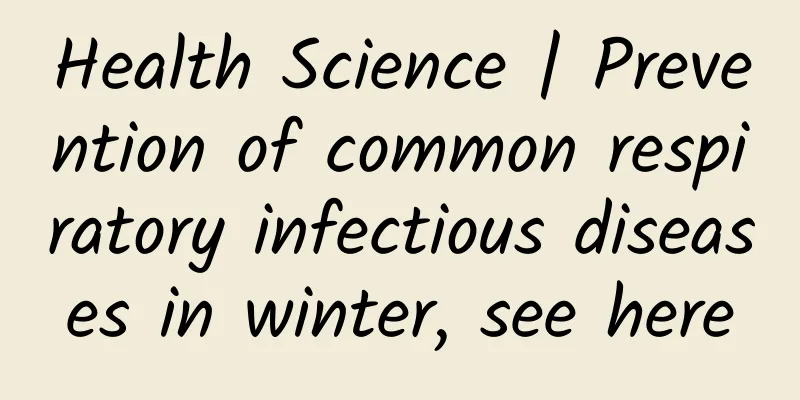Health Science | Prevention of common respiratory infectious diseases in winter, see here

|
Health Science | Prevention of common respiratory infectious diseases in winter, see here Tongling Disease Control 1. What are the common respiratory infectious diseases? Respiratory infectious diseases refer to infectious diseases caused by pathogens invading the respiratory tract. They are mainly transmitted by patients or infected persons through droplets. Different respiratory diseases have different clinical manifestations. Common respiratory infectious diseases in recent years include Mycoplasma pneumoniae infection, influenza, respiratory syncytial virus infection, adenovirus respiratory infection, and varicella. 2. Introduction to Common Respiratory Infectious Diseases 1. Influenza It is mainly caused by influenza A and B viruses and is highly contagious. Systemic symptoms such as high fever, headache, muscle aches, and fatigue are more severe. A few people have digestive tract symptoms such as nausea, vomiting, and diarrhea. The course of the disease generally lasts about 1 week. It is mainly transmitted through air droplets, and can also be transmitted through direct or indirect contact, as well as in the form of aerosols. Influenza vaccination is an effective way to prevent human influenza from becoming ill and spreading. 2. Mycoplasma pneumonia Pulmonary inflammation caused by Mycoplasma pneumoniae infection. Symptoms include fever and irritating dry cough, which may be accompanied by headache, runny nose, sore throat, etc. It is mainly transmitted through droplets, but can also be transmitted through contact. The incubation period is relatively long, averaging 2-3 weeks. People of all ages are generally susceptible, and children are a high-risk group, especially those over 5 years old. There is currently no targeted vaccine. 3. Respiratory syncytial virus infection Mild and early symptoms of RSV infection are similar to those of the common cold. In severe cases, patients may experience difficulty breathing or shortness of breath, wheezing, irritability, loss of appetite, etc. It is mainly transmitted through droplets and close contact. Infants and young children under 5 years old, especially those under 2 years old, are susceptible. It is mainly transmitted through droplets and close contact. The course of the disease generally lasts 1-2 weeks. There is currently no targeted vaccine. 4. Chickenpox is caused by the varicella-zoster virus. Symptoms include chills, low fever, headache, fatigue, cough, loss of appetite, and rash. Patients may develop papules, blisters, and scabs all over their bodies at the same time. The rash first appears on the trunk and then extends to the face and limbs. The source of infection is chickenpox patients. It is transmitted through respiratory droplets and direct contact, and can also be indirectly transmitted through contact with contaminated utensils. It is highly contagious and more common in children. The peak incidence is in winter and spring. Patients should be isolated from the respiratory tract until all herpes scabs have formed. They should rest in bed during the fever period and pay attention to replenishing water. Antiviral treatment can be carried out in the early stage according to the doctor's advice. Chickenpox vaccine can be administered for prevention. 5. Adenovirus respiratory tract infection The main symptoms are cough, nasal congestion and pharyngitis, accompanied by fever, chills, headache and muscle aches, etc. Pharyngitis, pharyngitis, conjunctivitis and pneumonia may also occur. It is mainly transmitted through droplets or touching contaminated objects without washing hands and touching the mouth, nose or eyes. It can also be transmitted through the fecal-oral route. It most often occurs in children aged 6 months to 5 years, especially children under 2 years old. The course of the disease generally lasts 1-2 weeks. There is currently no targeted vaccine. 3. How to effectively prevent it? 1. Practice healthy behaviors and lifestyles In daily life, we should actively advocate a healthy lifestyle, maintain adequate sleep, adequate nutrition, and proper physical exercise to achieve the goal of enhancing physical fitness and improving body resistance. 2. Vaccination Vaccination is the most economical and effective means to prevent infectious diseases. Schools are crowded places, and teachers, students and cohabitants should actively get vaccinated against influenza, chickenpox and other vaccines to build an immune barrier. 3. Wash your hands frequently Washing hands can reduce the risk of contact with pathogens and infection. Frequent hand washing is a very important habit for protecting against respiratory infectious diseases caused by influenza, especially after coughing or sneezing, before eating or after contact with contaminated environments. Pay attention to washing hands more often and thoroughly. 4. Ventilate frequently It is also very important to keep the home and workplace environment clean and well ventilated. Pay attention to cleaning the room and opening windows for ventilation. 5. Wear a mask. Respiratory infectious diseases are mainly transmitted through droplets. It is very important to wear a mask correctly. You must wear a mask when taking public transportation or entering crowded places such as shopping malls, supermarkets, and hospitals. 6. Avoid gathering during the peak season of the epidemic. Try to avoid going to crowded and poorly ventilated areas and avoid close contact with patients with respiratory infections. Try not to go to confined areas with poor air circulation. If you must go out, it is recommended to wear a mask, take good self-protection, and pay attention to changing it in time. 7. Maintain good respiratory hygiene habits When coughing or sneezing, be sure to cover your mouth and nose with a tissue or towel. Wash your hands promptly after coughing or sneezing, and try to avoid direct contact with your eyes, nose, mouth and other parts with your hands. Finally, please note that if you have symptoms such as fever, cough, sore throat, runny nose, etc., you should take the initiative to rest at home and not go to class or work while sick. Most respiratory infectious diseases are self-limiting and do not require antiviral treatment. Symptomatic treatment can cure the disease. However, it is recommended that the elderly, children under 5 years old, and special groups with low immunity seek medical attention in time to avoid worsening of the disease. |
<<: Why are respiratory infections particularly severe this winter?
>>: Night Listening|Does "right-angled shoulders" look good? It's not necessary
Recommend
What should I do if I bleed on the fifth day after abortion?
Many women have unexpected pregnancies, so they n...
What are the three types of breast fibroids?
The mammary gland is the glandular tissue inside ...
How to treat kidney deficiency and cold uterus? Remember these methods!
Kidney deficiency and uterine cold are plaguing t...
What is the menstrual period called?
For women with normal menstruation, the menstrual...
How long does it take to recover after minimally invasive hysterectomy surgery?
After a hysterectomy, women should do a good job ...
How many days after menstruation does ovulation occur?
A woman's body begins to have menstrual sympt...
Will hot springs affect menstruation?
Because of their own physiological conditions, wo...
Can Vitamin C Prevent Colds?
Recently, due to weather changes and the prevalen...
How long does it take for menstruation to come after induced abortion?
Due to various reasons, many women have to have i...
A lot of leucorrhea like snot
Women's reproductive health is something that...
What to do if you feel chest tightness when you are two months pregnant
Pregnant women who feel anxious and short of brea...
Can I eat mangosteen while drinking milk? What are the nutritional values of mangosteen?
Mangosteen, also known as mangosteen, is a tropic...
How long is a course of treatment for gynecological gel?
The main treatment of vulvar inflammation, vulvar...
Is there fetal movement in 2 months of pregnancy?
Usually in the early stages of pregnancy, mothers...
Can the warm nest recover if it ages prematurely?
After premature ovarian failure occurs, many fema...









